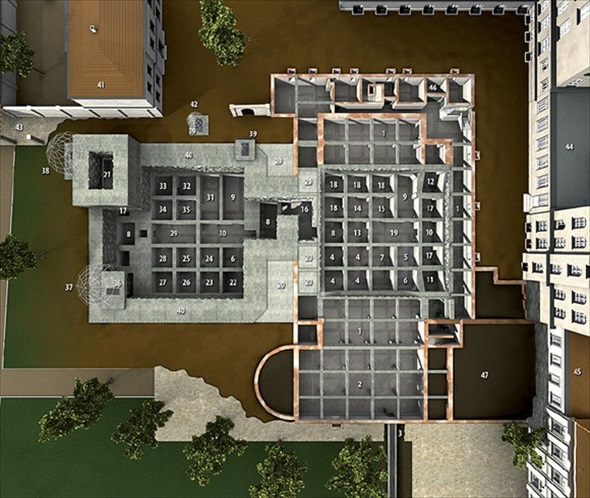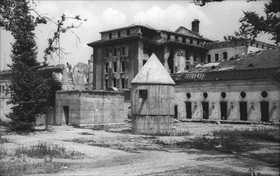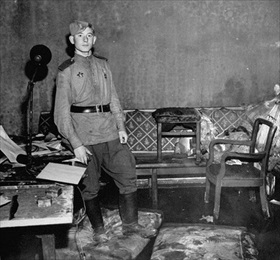HITLER TAKES SANCTUARY IN UNDERGROUND BUNKER
Berlin, Germany • January 16, 1945
The Soviet Union’s offensive that began on the Vistula River, the principal river in Poland, on January 12, 1945, spread out over the following days to engulf Nazi Germany’s entire Eastern Front, running from the Baltic Sea in the north to the Carpathian Mountains in Southern Poland. Four days later, on this date in 1945, Adolf Hitler moved his entourage into the Fuehrerbunker in Berlin, where he lived and directed the last months of the war in Europe.
The Fuehrerbunker (“Leader’s bunker”) complex—a maze of living and sleeping quarters, conference rooms, offices, and utilities spreading 2 stories deep beneath the Old Chancellery building and the chancellery gardens (see schematic diagram below)—had been greatly expanded from the original 1936–37 “air raid cellar,” where Hitler had found refuge during the first British bombing raids on the Nazi capital in August 1940. After the Luftwaffe’s loss of control of German airspace, Hitler gave architect Albert Speer (pronounced “spare”) the assignment to design a new, stronger, deeper bunker with 3.5 meter-thick ceilings and 3.5–4.0 meter-thick walls in close proximity to the existing shelter. The interior dimensions of both the Vorbunker (forward bunker) (old) and the Fuehrerbunker (new) were about 15 meters by 20 meters wide and a bit over 3 meters high. Completed in October 1944, another meter-thick layer of so-called “smash-cover” was being added to reinforce the ceiling of the Fuehrerbunker, 33 feet/10 meters below the surface, when the war ended.
Hitler was joined in this subterranean, clammy, claustrophobic environment by his personal physician, Dr. Thomas Morell (room no. 33 in the schematic diagram below); Eva Braun, his mistress of nearly 15 years (no. 24); and Joseph Goebbels, Nazi propaganda minister and Hitler diarist who, with his wife and 6 children, took up residence in both the Vorbunker (no. 18) and the Fuehrerbunker (no. 34).
On March 20, 1945, above the Fuehrerbunker a motley collection of roughly 50 Hitler Youth and SS troops gathered in the desolate garden of the Reichs Chancellery. In the presence of cameramen and photographers from the Wochenschau News, a visibly ailing Hitler made his last public appearance for the news media, awarding the men and boys the Iron Cross for their heroic deeds in defending the capital. Few people ever saw this final Wochenschau newsreel because the majority of German movie houses had been put out of commission by intense Allied air raids.
As Red Army troops fought their way into the last square mile/2.6 kilometers of Nazi-held Berlin at the end of April 1945, the bunker complex became the wedding venue and the gravesite of Hitler and Braun. On April 29, 1945, the 2 lovers were married in a brief civil ceremony held in the small conference/map room (no. 28) adjacent to Hitler’s private quarters (nos. 25–27); he was 56, she was 33. (Within 24 hours of exiting the Fuehrerbunker the hapless person who officiated at the wedding was shot and killed by a Soviet soldier; his body was never found.) In the afternoon of April 30, 1945, in Hitler’s personal study (no. 25), Braun bit into a capsule of cyanide and her husband fired a bullet into his right temple as he, too, bit into a cyanide capsule. Per the Fuehrer’s verbal and written instructions, pall bearers bore the corpses up the stairs and out the bunker’s emergency exit (no. 21), poured gasoline over them, and set them afire in the chancellery garden. After rendering their dead leader a last “Heil Hitler,” the pall bearers scurried back into their underground sanctuary.
The Fuehrerbunker: Hitler’s and Braun’s Initial Gravesite
 |
Above: Schematic in July 1947, this photo shows the massive first emergency exit of the main bunker (erster Notausgang des Hauptbunkers), or the rear entrance to the Fuehrerbunker (no. 21 in the schematic diagram above). Hitler and Braun were cremated in a shell hole in front of the emergency exit. The cone-shaped structure in the center of the photo (no. 37) served as an observation tower and bomb shelter for the guards. An unfinished tower (no. 38), a ventilation tower, is partially hidden behind the tree.
 |  |
Left: Taken in July 1947, this photo shows the massive first emergency exit of the main bunker (erster Notausgang des Hauptbunkers), or the rear entrance to the Fuehrerbunker (no. 21 in the schematic diagram above). Hitler and Eva Braun were cremated in a shell hole in front of the emergency exit that led into the chancellery garden. The cone-shaped structure in the center of the photo (no. 37) served as an observation tower and bomb shelter for the guards. An unfinished tower (no. 38), a ventilation tower, is partially hidden behind the tree.
![]()
Right: A young Soviet soldier stands reputedly amid the scattered remains of Hitler’s study and living room (no. 26), the place of his and his wife’s suicides on April 30, 1945. A Dutch still life that once hung over the sofa is missing. On December 5, 1947, Soviet engineers tried dynamiting Hitler’s bunker complex but had limited success. Both ventilation towers and the entrance structure seen in the picture on the left were destroyed in the blasts. Twelve years later the East German government applied more dynamite to the bunker ruins, then covered everything over with earth. In the second half of the 1980s East German work crews finished demolishing the site and built residential housing and other buildings in the space where the 2 Reich chancelleries, garden, and bunker complex had been. A children’s playground occupies the spot where Hitler’s and Braun’s bodies were burnt.
The Last Days of Adolf Hitler. Video Consists of Contemporary Soviet Footage of the Battle of Berlin
![]()

 History buffs, there is good news! The Daily Chronicles of World War II is now available as an ebook for $4.99 on Amazon.com. Containing a year’s worth of dated entries from this website, the ebook brings the story of this tumultuous era to life in a compelling, authoritative, and succinct manner. Featuring inventive navigation aids, the ebook enables readers to instantly move forward or backward by month and date to different dated entries. Simple and elegant! Click
History buffs, there is good news! The Daily Chronicles of World War II is now available as an ebook for $4.99 on Amazon.com. Containing a year’s worth of dated entries from this website, the ebook brings the story of this tumultuous era to life in a compelling, authoritative, and succinct manner. Featuring inventive navigation aids, the ebook enables readers to instantly move forward or backward by month and date to different dated entries. Simple and elegant! Click 











